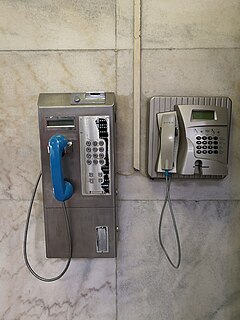
A telephone switchboard is a telecommunications system used in the public switched telephone network or in enterprises to interconnect circuits of telephones to establish telephone calls between the subscribers or users, or between other exchanges. The switchboard was an essential component of a manual telephone exchange, and was operated by switchboard operators who used electrical cords or switches to establish the connections.
Wide Area Telephone Service (WATS) was a flat-rate long distance service offering for customer dial-type telecommunications in some of the countries that adhere to the North American Numbering Plan. The service is between a given customer phone and stations within specified geographic rate areas, employing a single telephone line between the customer location and the serving central office. Each access line could be arranged for outward (OUT-WATS) or inward (IN-WATS) service, or both.

A payphone is typically a coin-operated public telephone, often located in a telephone booth or in high-traffic outdoor areas, with pre-payment by inserting money or by billing a credit or debit card, or a telephone card. Prepaid calling cards also facilitate establishing a call by first calling the provided toll-free telephone number, entering the card account number and PIN, then the desired connection telephone number. An equipment usage fee may be charged as additional units, minutes or tariff fee to the collect/third-party, debit, credit, telephone or prepaid calling card when used at payphones. By agreement with the landlord, either the phone company pays rent for the location and keeps the revenue, or the landlord pays rent for the phone and shares the revenue.

The North American Numbering Plan (NANP) is a telephone numbering plan that encompasses twenty-five distinct regions in twenty countries primarily in North America, including the Caribbean. Some North American countries, most notably Mexico, do not participate in the NANP.
Automatic number identification (ANI) is a feature of a telecommunications network for automatically determining the origination telephone number on toll calls for billing purposes. Automatic number identification was originally created by AT&T Corporation for internal long distance charging purposes, eliminating the need for telephone operators to manually request the number of the calling party for a toll call.

A telephone call is a connection over a telephone network between the called party and the calling party.
A toll-free telephone number or freephone number is a telephone number that is billed for all arriving calls instead of incurring charges to the originating telephone subscriber. For the calling party, a call to a toll-free number from a landline is free of charge.
In telecommunications, directory assistance or directory enquiries is a phone service used to find out a specific telephone number and/or address of a residence, business, or government entity.
A Zenith number was a special type of telephony service which allowed a calling party to call the number's owner at no charge by requesting the call from a switchboard operator and citing the "Zenith", "Enterprise" or "WX" number. The service preceded the system of toll-free telephone numbers with area code 800 in the United States.
Phone fraud, or more generally communications fraud, is the use of telecommunications products or services with the intention of illegally acquiring money from, or failing to pay, a telecommunication company or its customers.
In telecommunications, a long-distance call (U.S.) or trunk call (U.K.) is a telephone call made to a location outside a defined local calling area. Long-distance calls are typically charged a higher billing rate than local calls. The term is not necessarily synonymous with placing calls to another telephone area code.

The area code 868 is assigned to Trinidad and Tobago, a member of the North American Numbering Plan (NANP). The telephone numbering plan for the country is known as the National Numbering Plan. It is part of a system used for assigning telephone numbers in Trinidad and Tobago, and functions as a part of the North American Numbering Plan (NANP). It is regulated by the government's Telecommunications Authority, which holds responsibility for telecommunications.
The area code 246 in the North American Numbering Plan (NANP) is a composite part of the telephone numbering plan for Barbados. It is regulated by the government's Telecommunications Unit, which holds responsibility for telecommunications. The number 246 spells BIM, a nickname for the island.

The Spanish telephone numbering plan is the allocation of telephone numbers in Spain. It is regulated by Comisión del Mercado de las Telecomunicaciones (CMT).

A telephone number is a sequence of digits assigned to a fixed-line telephone subscriber station connected to a telephone line or to a wireless electronic telephony device, such as a radio telephone or a mobile telephone, or to other devices for data transmission via the public switched telephone network (PSTN) or other public and private networks.
Belarus began using its own country code +375 in 1995. Prior to that it was part of the +7 international country code. The local numbering plan was inherited from USSR and remains with little changes.
In the United States of America, Canada, and other countries participating in the North American Numbering Plan, a toll-free telephone number has one of the area codes 800, 833, 844, 855, 866, 877, and 888.
In conventional landline telephony, a non-dialable toll point or toll station was a lone station or line serving a rural subscriber many miles from the nearest central office. As it had no home telephone exchange and therefore no local calling area, all connections were obtained manually from the long distance operator.






